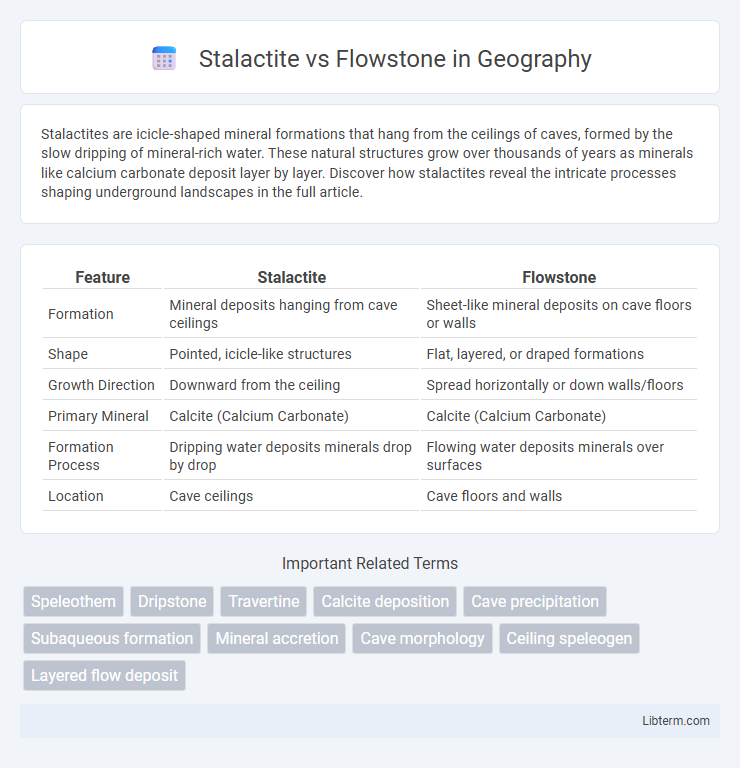Stalactites are icicle-shaped mineral formations that hang from the ceilings of caves, formed by the slow dripping of mineral-rich water. These natural structures grow over thousands of years as minerals like calcium carbonate deposit layer by layer. Discover how stalactites reveal the intricate processes shaping underground landscapes in the full article.
Table of Comparison
| Feature | Stalactite | Flowstone |
|---|---|---|
| Formation | Mineral deposits hanging from cave ceilings | Sheet-like mineral deposits on cave floors or walls |
| Shape | Pointed, icicle-like structures | Flat, layered, or draped formations |
| Growth Direction | Downward from the ceiling | Spread horizontally or down walls/floors |
| Primary Mineral | Calcite (Calcium Carbonate) | Calcite (Calcium Carbonate) |
| Formation Process | Dripping water deposits minerals drop by drop | Flowing water deposits minerals over surfaces |
| Location | Cave ceilings | Cave floors and walls |
Introduction to Cave Formations
Stalactites are icicle-shaped mineral deposits hanging from cave ceilings, primarily formed by the deposition of calcium carbonate from dripping water. Flowstone, on the other hand, forms sheet-like deposits on cave walls or floors as mineral-rich water flows over surfaces, creating smooth, layered formations. Both are key speleothems that reveal essential information about the cave's geological history and hydrology.
What are Stalactites?
Stalactites are icicle-shaped mineral formations that hang from cave ceilings, primarily composed of calcium carbonate deposited by dripping water saturated with dissolved limestone. These formations grow slowly over thousands of years as mineral-rich water droplets leave behind tiny crystals, gradually elongating. Unlike flowstone, which forms sheet-like deposits on cave walls and floors, stalactites develop as individual, tapering structures suspended above the cave floor.
How Stalactites Form
Stalactites form through the deposition of calcium carbonate as mineral-rich water drips from cave ceilings, creating icicle-shaped formations over thousands of years. Water saturated with dissolved calcium bicarbonate loses carbon dioxide upon contact with air, leading to calcite precipitation that gradually builds the stalactite structure. Unlike flowstone, which develops from mineral deposits flowing over walls or floors, stalactites hang directly overhead, growing downward from the ceiling.
What is Flowstone?
Flowstone is a type of speleothem formed by mineral-rich water flowing over cave walls or floors, depositing layers of calcite or other carbonate minerals. Unlike stalactites, which hang from cave ceilings as icicle-shaped formations, flowstones create smooth, sheet-like or drapery-like deposits that can cover large surfaces. These formations develop as continuous, thin films of water spread out, allowing minerals to precipitate and build up over time, often exhibiting banded patterns from varying mineral content.
Flowstone Formation Process
Flowstone forms as mineral-rich water flows over cave walls or floors, depositing layers of calcite, aragonite, or other carbonate minerals. The continuous deposition process creates smooth, sheet-like formations that differ from the icicle-shaped stalactites, which hang from ceilings by dripping water. Flowstone growth rates depend on factors such as water chemistry, flow velocity, and cave climate conditions, resulting in distinct patterns and textures.
Key Differences Between Stalactites and Flowstone
Stalactites are icicle-shaped mineral formations that hang from cave ceilings, primarily formed by the dripping of mineral-rich water, whereas flowstone develops as sheets of calcite or other minerals deposited on cave floors or walls by flowing water. The chemical composition of both is mainly calcium carbonate, but stalactites grow vertically downward, while flowstone spreads horizontally creating smooth or rippled surfaces. Structural differences include the hollow core in stalactites due to water drip passages, contrasting with the solid, layered buildup of flowstone.
Visual Characteristics and Identification
Stalactites are icicle-shaped formations hanging from cave ceilings, often narrow and pointed with a rough, dripstone texture, while flowstones form as smooth, sheet-like deposits over walls or floors, created by flowing water spreading mineral-rich layers evenly. Stalactites grow downward through mineral-laden water droplets, creating vertical, elongated shapes, whereas flowstones develop horizontally, resulting in banded, terraced appearance with glossy surfaces. Identifying stalactites involves spotting their distinct hanging, tapering form, contrasted by the broad, layered, and often ripple-patterned appearance typical of flowstone formations.
Role in Cave Ecosystems
Stalactites provide essential microhabitats in cave ecosystems by offering surfaces for specialized microorganisms and small invertebrates to colonize, contributing to biodiversity. Flowstones, with their widespread mineral deposits, help regulate cave humidity and water flow, supporting moisture-dependent species and stabilizing the cave environment. Both formations play crucial roles in maintaining the ecological balance within subterranean habitats.
Stalactite vs. Flowstone: Scientific Importance
Stalactites and flowstones are key speleothems in karst environments, providing valuable paleoclimatic records through their isotopic compositions and growth layers. Stalactites form from mineral-rich water droplets hanging from cave ceilings, recording episodic changes in drip rate and water chemistry, while flowstones develop from continuous mineral deposition over cave floors or walls, indicating more stable hydrological conditions. Their distinct formation mechanisms and geochemical signatures allow scientists to reconstruct past climate variability and understand cave hydrology over geological timescales.
Preservation and Conservation Efforts
Stalactites and flowstones require targeted preservation strategies due to their delicate mineral formations and susceptibility to damage from human contact and environmental changes. Conservation efforts focus on controlling cave microclimates by managing humidity and temperature, alongside restricting visitor access to minimize physical wear and contamination. Advanced monitoring technologies help track growth rates and detect potential threats, ensuring long-term protection of these speleothems' geological and ecological significance.
Stalactite Infographic

 libterm.com
libterm.com